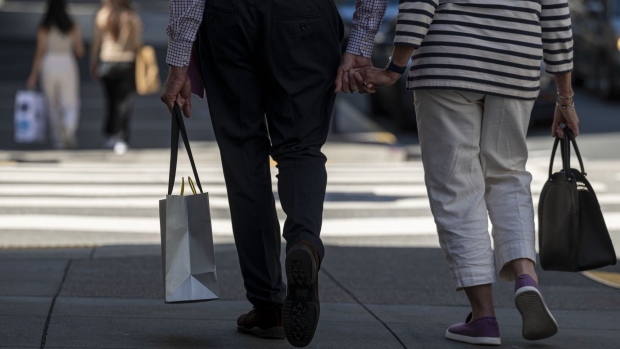Sep 14, 2023
US Retail Sales Top Estimates on Higher Gasoline Prices
, Bloomberg News

(Bloomberg) -- US retail sales showed signs of slowing in August as consumers limited their discretionary spending amid higher gasoline prices.
The value of total retail purchases increased 0.6% from July following downward revisions to the prior two months, Commerce Department data showed Thursday. Excluding gasoline, sales climbed 0.2%, among the weakest this year.
The figures aren’t adjusted for inflation.
Sales rose in most retail categories last month, including at clothing and electronics stores. That said, most of the other sectors — like grocery and department stores — showed some deceleration from the prior month.
Even though the figures still point to resilient spending, the report shows how consumers are feeling the pinch of higher prices, particularly those at the gas pump. Some Americans are relying on credit cards and savings, and a slowly softening job market plus the imminent resumption of student-loan payments will limit spending going forward.
“Despite rising real wages and a rebound in wealth, the mighty consumer seems to have stepped back in August due to high interest rates, costlier fuel, fading excess savings and slowing job growth,” Sal Guatieri, senior economist at BMO Capital Markets, said in a note.
A separate report Thursday showed initial applications for unemployment benefits rose only slightly last week but remained generally low, still indicating strong demand for workers.
Consumers have also been dealing with higher borrowing costs. A report Wednesday showed underlying US inflation rose in August by more than forecast, keeping the door open for the Federal Reserve to hike interest rates again later this year — though officials are expected to hold steady at their meeting next week.
That data also showed that the overall consumer price index advanced by the most in over a year, largely due to higher energy costs. Receipts at gasoline stations jumped 5.2%, the most in over a year, according to the retail sales report.
Another release Thursday showed US producer prices increased in August by the most in more than a year, boosted by rising energy and transportation costs.
In addition to not being adjusted for inflation, the retail figures largely reflect spending on goods, rather than services, limiting the takeaways of this particular report. Real spending on both goods and services in August will be released later this month.
Sales at restaurants and bars — the only service-sector category in the report — climbed 0.3% in August, the least in five months. Receipts at grocery stores advanced for a second month.
So-called control group sales — which are used to calculate gross domestic product and exclude food services, auto dealers, building materials stores and gasoline stations — rose 0.1%, one of the weakest readings this year.
--With assistance from Chris Middleton.
(Adds graphic, economist’s quote)
©2023 Bloomberg L.P.






